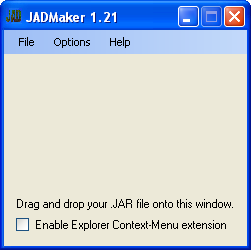Installing BlackBerry apps from your PC to your phone can be a bind. BlackBerry apps normally come in two flavors – JAR files or COD files. However, in order to install them via the BlackBerry Desktop Manager, they need to be accompanied by a separate loader file. For JAR files, this should be a JAD file, and for COD files, you’ll need an ALX file.
If you’re downloading a BlackBerry app and only the JAR or the COD is provided then you’ll need to perform a quick hack to obtain the appropriate loader file to install the app with Desktop Manager.
How to make a JAD file to install a JAR
To create a JAD file from a JAR, you should download JADMaker. This free tool, which requires no installation, converts JAR to JAD in seconds. All you do is double-click on the program icon and drag the JAR file into the JADMaker window. The file will be converted and saved into the same directory as the JAR. It’s then ready to be transferred to your phone using BlackBerry Desktop Manager.

How to make an ALX file to install a COD
An ALX file is simply a text file that provides information about the COD to your phone. You can create these files very easily.
Open Notepad and create a new text file then copy the following lines of code into it. The only text you actually need to change is the name of the COD file, which you enter in between the <files></files> tags. The other data can be edited if you wish, but you don’t need to for the creation of the ALX file.
<loader version="2010.29.07.0120">
<application id="My program name" _blackberryVersion="[4.2.1,)">
<name>My program name</name>
<description></description>
<version>2010.29.07.0120</version>
<vendor>ACME software</vendor>
<copyright>Copyright (c) 2001-2010 ACME Software. All Rights Reserved.</copyright>
<fileset Java="1.0">
<files>
my_program_name.cod
</files>
</fileset>
</application>
</loader>

